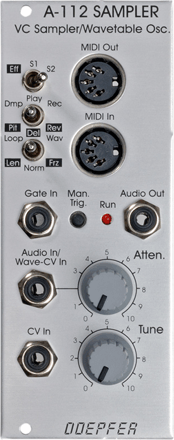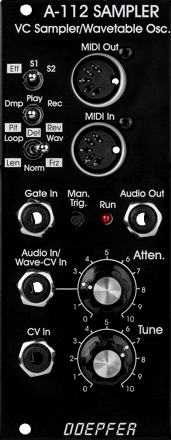nicht mehr im regulären Lieferprogramm / no longer available as a standard product
Restbestände werden über die Sonderliste zu Sonderpreisen angeboten / remainder of stock are offered at special reduced prices in the special list
http://navsmodularlab.blogspot.com/2011/07/doepfer-112-sampler-wavetable-osc.html
http://navsmodularlab.blogspot.com/2011/11/feedback-looper.html
 |
 |
|
Vintage Edition |
|
Das Modul
A-112 ist ein kombiniertes Modul aus spannungsgesteuertem 8-Bit-Sampler und
Wavetable-Oszillator. Darüberhinaus ist es in der Lage eine Reihe von Effekten zu erzeugen. Es ist
als ergänzendes Klangerzeugungs-Modul im A-100 mit den charakteristischen
Klangeigenschaften der frühen 8-Bit-Sampler zu sehen und ist nicht mit den auf dem Markt
erhältlichen MIDI-Samplern zu vergleichen!
Sampling-Betriebsart: 8-Bit-Audio-Auflösung, 128kB Speicher in 2 Bänken (S1, S2) zu je
64KB (dies entspricht 2 Sekunden Samplingzeit bei 32kHz Sampling-Frequenz), Audio-Eingang
mit Abschwächer, Übersteuerungs-Anzeige im Aufnahme-Modus (Gate-LED),
MIDI-Dump-Möglichkeit zur Archivierung von Klängen, nicht flüchtiger Speicher für die
im Modul befindlichen Samples, manueller Tune-Regler für die Einstellung der
Sampling-Rate bei Aufnahme und Wiedergabe, der CV-Eingang (~ 1V/Oktave) bestimmt zusammen
mit dem Tune-Regler die Sampling-Rate bzw. Tonhöhe (Tonumfang 5 Oktaven entsprechend
0...+5V), Gate-Eingang (kein reiner Trigger, sondern das
Sample wird bei der positiven Flanke gestartet und läuft ab, solange der Gate-Eingang
'high' oder das Ende des Samples erreicht ist), manualler Gate-Taster, ungefilteter
Audio-Ausgang (d.h. es können bewusst Quantisierungs-Geräusche zur Klangerzeugung
verwendet werden).
Wavetable-Betriebsart: Sonderform der Sampling Betriebsart, wobei der Audio-Eingang nun
als Steuereingang zum Durchfahren des Samples in 256 Byte großen Adressbereichen (Tables)
verwendet wird. Die zum Durchfahren aller Wavetables benötigte Steuerspannung
am Eingang "Wave CV In" liegt bei voll aufgedrehtem Regler
"Atten." im Bereich von ca. -2,5V (Wavetable 1) ... 0V (Wavetable 127)
... +2,5V (Wavetable 256). Befinden sich im Sampling-Speicher entsprechende Wavetables
(z.B. per
MIDI-Dump geladen) so erhält man auf diese Weise einen Wavetable-Oszillator, bei dem
verschiedene Wellenformen (mit unterschiedlichem Obertongehalt) per CV durchfahren
werden. Mit dieser Betriebsart kann aber auch ein "normales" Sample
"durchfahren" werden, was z.T. ganz erstaunliche Klänge ergibt (interessant
auch zum "Durchfahren" von Sprache, wobei dann die Sprachfetzen sehr extreme
Klangstrukturen ergeben). Eine ideale Ergänzung für diese Anwendung ist das
Offset/Abschwächer-Modul A-183-2, mit dem die Position
der Start-Wavetable (Offset) und die Modulationstiefe (Att.) eingestellt werden
können. Der betreffende Jumper des Modul A-183-2 muss
dazu für den symmetrischen Offset-Bereich eingestellt werden (da -2,5 ... +2,5V
zum Durchfahren alles Wavetables benötigt werden). Für die Modulation kann z.B. ein LFO (A-145, A-146, A-147), ein ADSR
(A-140, A-141, A-142, A-143-1/2) oder eine Zufallsspannung (A-118,
A-149-1) verwendet werden. Aber auch ein
Ribbon-Controller (A-198 oder R2M),
ein Theremin A-178, Joystick A-174
oder Modulationsräder A-174-2 bieten sich zum
Durchfahren der Wavetables an.
Effekte: Zusätzlich bietet das Modul - sozusagen als kostenlose Dreingabe - einige
Effekte wie z.B. Delay, reverse Delay, Pitch-Shifter, Freeze. Es muss aber betont werden,
dass diese Effekte auf Grund der 8-Bit-Auflösung nicht mit dem Ergebnis hochwertiger
Effektgeräte zu vergleichen sind und nur als kostenlose Dreingabe für abgefahrene Sounds
verstanden werden sollten.
Die Sampling-Zeit des A-112 liegt bei ca. 1...30 Sekunden. Dies entspricht einem Bereich für die Sampling-Frequenz von ca. 60kHz...2kHz (64kB@60kHz ~ 1s, 64kB@2kHz ~ 30 s).
Technischer Hinweis: Da für die nicht-flüchtige Speicherung ein Akku verwendet wird, sollte dieser in regelmäßigen Abständen überprüft und ggf. gewechselt werden. Näheres hierzu auf der FAQ-Seite unserer Website: Lebensdauer von Akkumulatoren
Die deutsche Bedienungsanleitung ist als PDF-Datei
auf unserer Website verfügbar: ![]() A112_anl.pdf.
A112_anl.pdf.
DOEPFER A-112
SAMPLEDUMPLOADER :
Programm zum Transfer von A-112 Samples in Wavefiles (*.WAV) und
umgekehrt via MIDI System Exclusive Message. Lauffahig unter DOS 5.0+ und Windows 95 (nur
bedingt).
Module
A-112 is the combination of a voltage controlled 8 Bit Sampler and a wavetable oscillator.
On top of it the module is able to generate some special effects. A-112 was designed as an
additional sound source with the typical sounds of the early 8 bit samplers and is not
comparable with the modern polyphonic MIDI samplers available on the market.
Sampling mode: 8 bit audio resolution, 128kB memory in 2 banks 64kB each
(equivalent to 2 seconds of sampling time for each bank with 32 kHz sampling rate), audio
input with attenuator, overload display in record mode (gate LED), possibility of MIDI
Dump to store sounds in a computer via MIDI, non volatile memory for the 2 samples in the
module, manual tune control for adjustment of sampling rate for record and play, CV input
(~ 1V/Oct), both manual tune and CV determine the sampling rate respectively the pitch
(pitch range is 5 octaves), gate input (not a trigger:
the sample starts at the positive edge of the gate signal and is played as long as gate is
high or until the end of the sample is reached), manual Gate button, non filtered audio
output (thus quantizing noise can be used as an element of the sound intentionally)
Wavetable mode: special appearance of the sampling mode when playing a sample, the
audio input is now used as a second control voltage input for moving through the sample in
256 byte wide loops (wavetables). The control voltage required to move through
all wavetables applied to the input "Wave CV In" is in the range -2.5V
(wavetable 1) ... 0V (wavetable 127) ... +2.5V (wavetable 256) when control
"Atten." is set fully clockwise. To achieve the typical wavetable oscillator sounds the
sampling memory must contain corresponding wavetable data (e.g. loaded via MIDI dump).
These data contain a set of wavetables with different harmonic content (e.g. a filter
sweep) to get the typical wavetable sound while moving through the tables via
CV. But you
may also use a "normal" sample and go through the sample with CV to obtain
partially amazing sounds never heard before. You may use for example sampled speech and go
with CV through the syllables or speech shreds to get really very extreme sounds.
An ideal addition for this feature is the Offset/Attentuator module A-183-2
which can be used to adjust the position of the wavetable (Offset) and the
modulation depth (Att.). The corresponding jumper of the A-183-2
has to be set to bipolar offset (as the A-112 requires -2.5V...+2.5V to pass
through all 256 wavetables). As modulation source an LFO (A-145, A-146, A-147,
A-143-3), ADSR (A-140, A-141, A-142, A-143-1/2) or a random voltage (A-118,
A-149-1) may be used. Even a ribbon controller (A-198
or R2M), the Theremin module A-178,
the Joystick A-174 or the Wheels module A-174-2
are useful to drive through the wavetables.
Effects: Additionally the module offers - in a way free of charge - some effects like
delay, reverse delay, pitch shiftinng or freeze. But it has to be pointed out that due to
the 8 bit audio resolution these effects are not comparable to high quality effect units
and should be understand as an extra for nothing. The A-112 is not an effects unit !
The sampling time of the A-112 is about 1...30 seconds corresponding to a sampling frequency range of about 60kHz...2kHz (64kB@60kHz ~ 1 s, 64kB@2kHz ~ 30 s).
Technical note: the module uses a battery for the non-volatile storage of the sampling data. Batteries have a limited lifespan and have to be inspected at least every two years. For details please refer to the FAQ page of our website: Lifespan of rechargeable batteries (used for memory backup)
For more detailed information please look at the
English user's manual ![]() A112_man.pdf.
A112_man.pdf.
DOEPFER A-112
SAMPLEDUMPLOADER : Programm to transfer A-112 Samples in wavefiles (*.WAV) and revers via
MIDI System Exclusive Message. DOS 5.0+ and Windows 95 (in Dos-Window - not guaranteed).
Some sound examples made by one of our customers: http://navsmodularlab.blogspot.com/2011/07/doepfer-112-sampler-wavetable-osc.html
Breite/Width: 10TE / 10HP / 50.5
mm
Tiefe/Depth: 100 mm (gemessen ab der Rückseite der Frontplatte / measured from
the rear side of the front panel)
Strombedarf/Current: +50mA (+12V) / -20mA (-12V)
Standard Version
:
Euro 165.00
Vintage
Edition : Euro
180.00
nicht mehr im regulären
Lieferprogramm / no
longer available as a standard product
Restbestände werden über die Sonderliste
zu Sonderpreisen angeboten / remainder of stock are offered at special reduced
prices in the special list